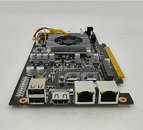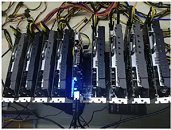- Joined
- Oct 9, 2007
- Messages
- 47,537 (7.47/day)
- Location
- Hyderabad, India
| System Name | RBMK-1000 |
|---|---|
| Processor | AMD Ryzen 7 5700G |
| Motherboard | ASUS ROG Strix B450-E Gaming |
| Cooling | DeepCool Gammax L240 V2 |
| Memory | 2x 8GB G.Skill Sniper X |
| Video Card(s) | Palit GeForce RTX 2080 SUPER GameRock |
| Storage | Western Digital Black NVMe 512GB |
| Display(s) | BenQ 1440p 60 Hz 27-inch |
| Case | Corsair Carbide 100R |
| Audio Device(s) | ASUS SupremeFX S1220A |
| Power Supply | Cooler Master MWE Gold 650W |
| Mouse | ASUS ROG Strix Impact |
| Keyboard | Gamdias Hermes E2 |
| Software | Windows 11 Pro |
Colorful today introduced the uniquely designed C.J1900A-BTC PLUS V20 motherboard for mining rigs. This odd-ball form-factor board is designed for makeshift racks, and removes the need for PCIe riser cables. The board itself is a large PCB with nine PCI-Express x16 slots with 1-slot spacing, of which eight can be used for installing your mining graphics cards (x1 wiring), while the slot on the middle (blue), isn't really a PCI-Express slot.
The blue slot has custom wiring for the business end of the motherboard, a riser card which houses the Celeron J1900 SoC, a DDR4 SO-DIMM slot, an mSATA 6 Gb/s slot for your SSD, and the board's main connectivity, which includes two USB 2.0 ports, two gigabit Ethernet interfaces, and an HDMI display output. If you have trouble finding an mSATA SSD in 2017, there's also a standard SATA 6 Gb/s port. The riser draws power from a 4-pin ATX input. The main PCB has eight 6-pin PCIe power inputs, which wire out to 6-pin PCIe outputs near each black slot. This is more of a cable-management feature, smaller (20 cm long) male-to-male 6-pin PCIe cables connect the outputs to the graphics cards.





View at TechPowerUp Main Site
The blue slot has custom wiring for the business end of the motherboard, a riser card which houses the Celeron J1900 SoC, a DDR4 SO-DIMM slot, an mSATA 6 Gb/s slot for your SSD, and the board's main connectivity, which includes two USB 2.0 ports, two gigabit Ethernet interfaces, and an HDMI display output. If you have trouble finding an mSATA SSD in 2017, there's also a standard SATA 6 Gb/s port. The riser draws power from a 4-pin ATX input. The main PCB has eight 6-pin PCIe power inputs, which wire out to 6-pin PCIe outputs near each black slot. This is more of a cable-management feature, smaller (20 cm long) male-to-male 6-pin PCIe cables connect the outputs to the graphics cards.





View at TechPowerUp Main Site













